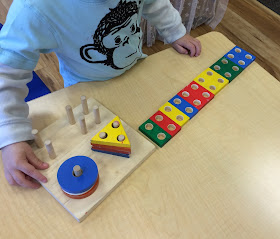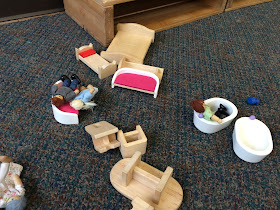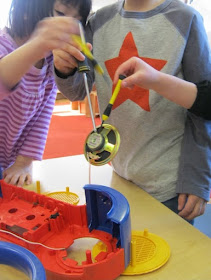All of us – children, teachers, parents – have some toys
we like more than others. I’m personally not a huge fan of math manipulatives
that involve sorting for the sake of sorting, or fitting pieces together for
the sake of fitting them together. I’m a lot more interested in manipulatives
that can be used for creative building, or that can be used in a variety of
ways – not the “self correcting” way where if a child doesn’t do what the toy
designer planned, they can’t complete the task.
But, materials speak to everyone a variety of ways, so
even if a toy isn’t one of my personal favorites, I still have it in my
classroom, because one of the children might find it interesting even if I don’t.
There’s also the tricky balance of selecting materials that meet the needs of
all the children – ones that are challenging enough for older children but not
frustrating for younger ones. One of things that’s appealing about open ended
and “found” materials is that children can use them in a variety of ways, at
whatever developmental level a child is at.
But, even if a toy seems to be close ended, giving
children the freedom to explore and find novel ways to use that toy encourages
innovation and problem solving. I saw this as my two-and-three year olds
explored “Geometric Sorting Boards”. These are puzzle like contraptions that
have multi-colored geometric tiles that fit onto pegs. Each geometric shape has
a different number of holes, with the presumed goal that the children will line
up the correct tile over the correct pegs. According to the manufacturer, this
toy teaches “math concepts” “shape recognition” “color and pattern recognition”
and “early geometry”. What I notice more often is that this toy is frustrating,
because it’s hard to line the holes up over the pegs. And most preschool age
children aren’t developmentally able to consider multiple characteristics of an
object simultaneously – color, shape, number of holes, number of holes, and
most of all, considering number of holes and number of tiles at the same time.
So, what did young preschoolers do with the geometric
shape boards?
They took the shapes off the pegs. They stacked the
shapes and lined them up. They carried the shapes to other parts of the room
and pretended that the circles were cookies.
A few children tried to fit the shapes back on the
pegs, but quickly lost interest. The pegs weren’t as interesting as the shapes
themselves.
As I wrote in my
last post, children will play their way with whatever we give them. We don’t
need to “teach” children colors, geometry, and number – those concepts are
embedded in the objects all around them. And trying to “teach” a concept they
aren’t interested in isn’t going to work. Real learning takes place through
self-initiation, exploration, and innovation.



















